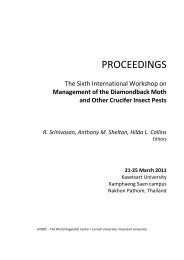Leguminous Vegetable Cultivation and Seed Production S ...
Leguminous Vegetable Cultivation and Seed Production S ...
Leguminous Vegetable Cultivation and Seed Production S ...
You also want an ePaper? Increase the reach of your titles
YUMPU automatically turns print PDFs into web optimized ePapers that Google loves.
<strong>Seed</strong> <strong>Production</strong> Technology of Garden Peas<br />
S.<br />
Shanrnugasundaram<br />
Garden peas are one of the four most important seed legumes. It occupies an important<br />
place among the winter vegetables in India. In the North Indian hills, it is the most important offseason<br />
vegetable grown both as a summer <strong>and</strong> autumn crop. It is cultivated in states like<br />
Bihar, TYL9 ' , Aauonn.MoburobLru,Delhi, West Bengal, Punjab, uodHinoaoboJPradesh. The most<br />
important garden pea growing state iu}3.P.which accounts for more than 60 % of production.<br />
In self-pollinated crops like garden pea, hybrid vigor is commonly found when different<br />
purelines are crossed. Since self-polliooUioo is the general rule, inbreeding is necessary to obtain<br />
pozeIiueoin this group of plants.<br />
Whether or not it is economically feasible to use hybrid vigor depends upon the cost of<br />
producing the hybrid seed in relation to the value of the increased yields. Since most self-pollinated<br />
crops produce urclativeln small amount of pollen, which is not transferred by the wind or by<br />
insects to any significant degree, h<strong>and</strong> pollination is most likely necessary to bring about u1rans{er<br />
of pollen between plants. If many seeds are produced by each h<strong>and</strong> pollination then the increased<br />
yield justifies hybridization for greenhouse <strong>and</strong> early market use. With a crop like garden peas, it is<br />
very unlikely that hybrids will ever be used because of difficulty of h<strong>and</strong> pollination <strong>and</strong> the small<br />
number of seeds produced per pollination.<br />
The production of quality seeds not only involves the selection of the best <strong>and</strong> true to type<br />
plants in varieties of different vegetables but also the adoption of specific techniques suited to each<br />
kind. For the production of good quality seeds such information as whether a particular crop is<br />
self-pollinated or cross-polliootcd is absolutely oeceaary,as the technique to be used will depend<br />
on it.<br />
<strong>Seed</strong> <strong>Production</strong><br />
<strong>Seed</strong>s of garden peas of almost all varieties can be quite efficiently produced in the North<br />
Indian plains. Therefore, there seems to be no real advantage in producing pea seed in the hills for<br />
supplying to the vegetable growers in the plains.<br />
The agronomic practices to be followed for crops raised for seed production are the same as<br />
for those raised for commercial green pod purposes. Some of the important aspects of cultivation<br />
are:<br />
Soil <strong>and</strong> Climatic Requirements:<br />
Peas can be<br />
in a variety of soils, from light s<strong>and</strong>y loam to clay though the best<br />
results are achieved on well drained loose, friable loamy soils, <strong>and</strong> not in acidic soils. The most<br />
favorablepH range is between 6.0 uod7.5.<br />
Peas prefer cool weather; they do not grow well during the intense heat of summer. The<br />
blossoms <strong>and</strong> pod are more susceptible to frost than the leaves uods1e000.Tbe seeds can germinate<br />
at nroinicunzo temperature of 50C; the optimum temperature for germination is about 220C. At<br />
higher temperatures, germination is rapid but loss of st<strong>and</strong> may result from various decaying<br />
organiazom.<br />
}
















